Back to articles

Supernatural, amazing, fabulous
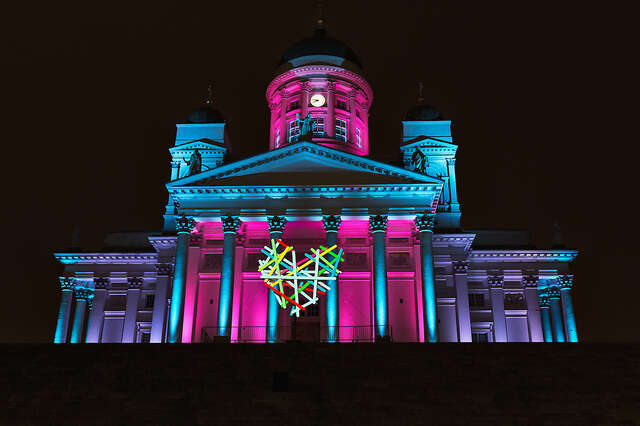
LUX Helsinki is a five-day festival of light taking place in the Helsinki centre during 4–8 January 2015. Architect Anne Tervo paid a visit to the festival and tells about her impressions.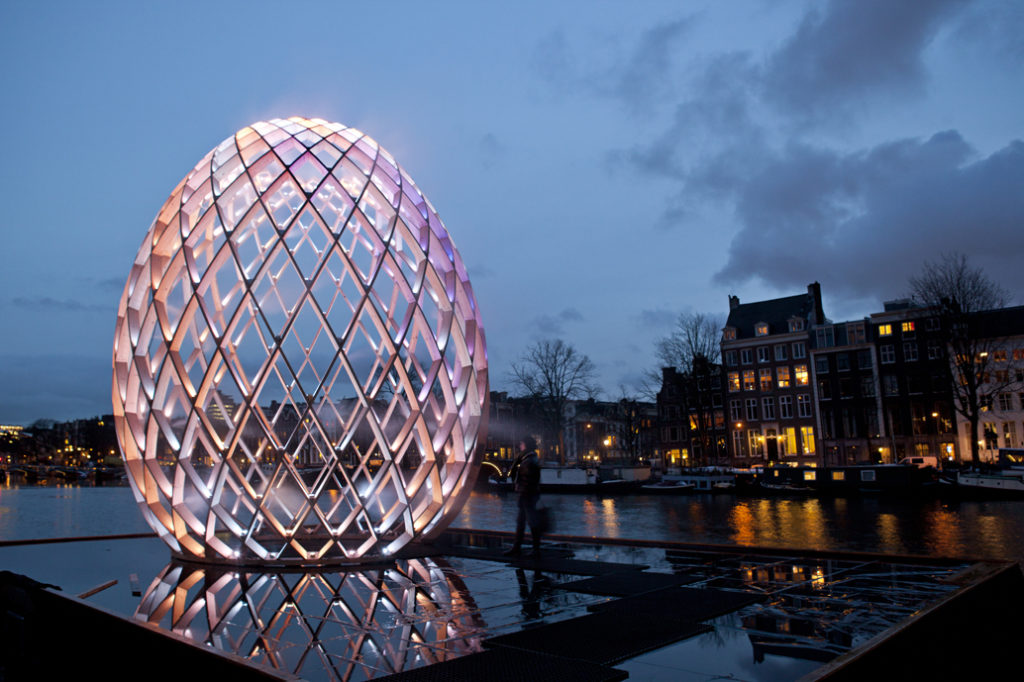 ACT Lighting Design & Odeaubois: OVO. Photo: Janus van de Eijinden. © Visit Helsinki / Helsingin Markkinointi Oy.[/caption]
ACT Lighting Design & Odeaubois: OVO. Photo: Janus van de Eijinden. © Visit Helsinki / Helsingin Markkinointi Oy.[/caption]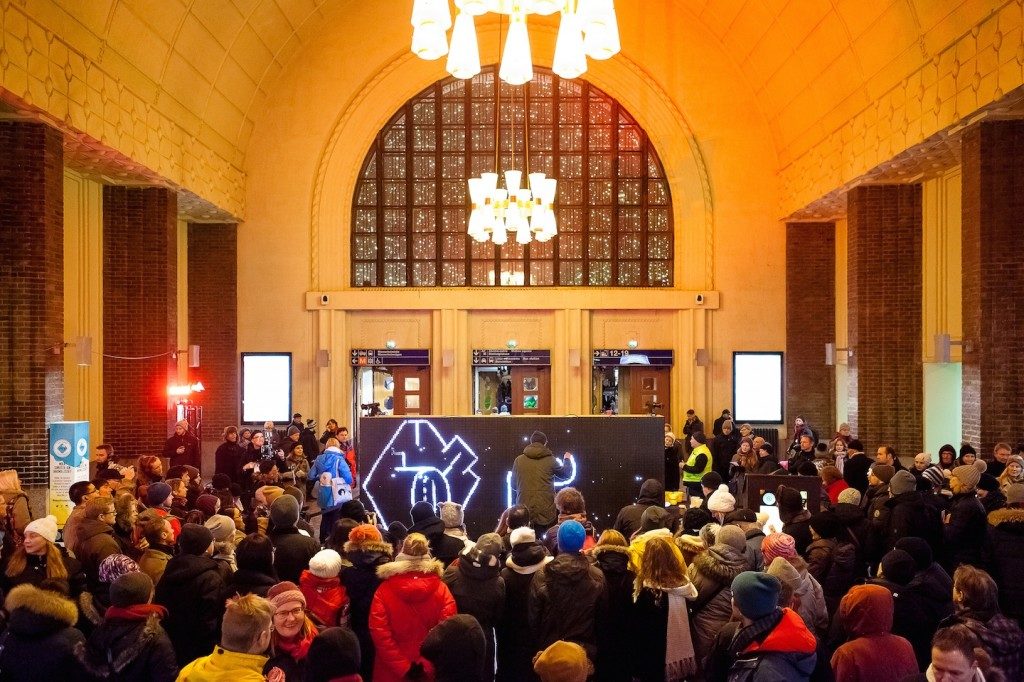
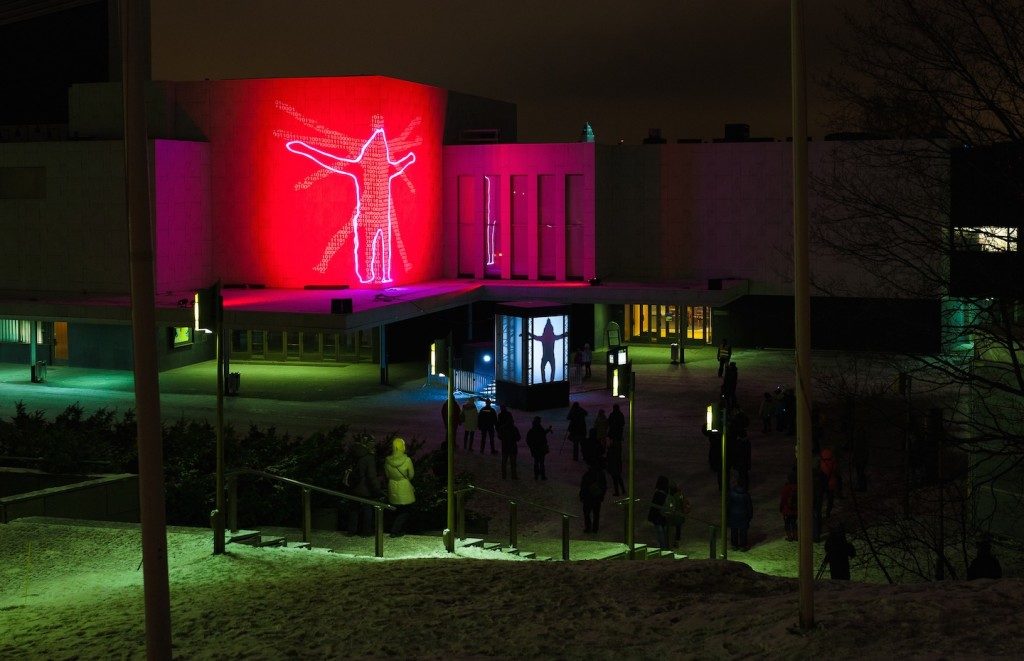 The Post Hall of the railway station is absolutely packed. Antonin Fourneau’s Water Light Graffiti is unambiguously interactive: it would not exist without participants. They paint patterns with water on a surface consisting of LEDs. On drying the water graffiti vanishes. The flow of people passing through the station hall emphasises in an excellent way the fleeting character of the art work. In a more dim light the graffiti would shine even brighter. Interactivity continues at the corner of the Finlandia Hall where the work Anonymous by the Lighting Design Collective Helsinki offers a protected cubicle containing a microphone and movement sensor. The marble facade of the building reproduces over a three-minute period the shape of the performer abstracted into unrecognisability. Very few inside the cubicle are able to stand still.The LUX Helsinki festival also includes artworks that are to be admired from a distance, and in that sense are more traditional. The installation at the Helsinki Cathedral was commissioned from Miika Riikonen to commemorate the 80th birthday of the composer Aulis Sallinen. The light licks the facades of the building accompanied by booming music, escaping behind the corner in order to return like a huge supermoon that has lost its orbit. The ability of the light beam to attract the gaze compensates for the detraction of the perception of the whole. In front of Helsinki University’s Porthania building people are standing quietly shoulder to shoulder. Mader Wiermann has conjured up a space-creating factory in the windows at street level, the shifting blocks of which shrink the scale of the building. Intentional or not, it’s possible to interpret the art work as a comment on the origins of Porthania, designed by architect Aarne Ervi and completed in 1957, when we recall that it’s one of the first significant buildings in Finland built from prefabricated concrete elements. Perhaps the boom and ruckus you hear comes instead from underground. Could it be that the book depositories in the basement have finally rebelled against the reading devices of the information era? Thomas A. Troge’s sound installation endorses this experience: yes, something may explode.The so-called Lantern Park, which in previous years has been located along Töölö bay, can this year be found in the Topelia block of Helsinki University. This is the most fabulous part of LUX Helsinki. The internal courtyard gathers together lanterns made by students from Aalto University and the University of the Arts Helsinki, bringing to mind people mingling at a party. That one over there has climbed up on to a balcony and is now peeking out through the railing. I wonder if the person is of an observant nature or just somewhat shy? Or perhaps the person really is an exhibitionist? And that young lady in the doorway lets the hem of her chiffon dress billow. At this time of night, tales of charming coquettes are more interesting than academic cubes and cylinders. Among the hundreds of lanterns there is fortunately something for everyone. With a grilled sausage in hand bought from the adjacent stall, you can set out to look for an art work that you feel portrays yourself.[caption id="attachment_1742" align="aligncenter" width="565"]
The Post Hall of the railway station is absolutely packed. Antonin Fourneau’s Water Light Graffiti is unambiguously interactive: it would not exist without participants. They paint patterns with water on a surface consisting of LEDs. On drying the water graffiti vanishes. The flow of people passing through the station hall emphasises in an excellent way the fleeting character of the art work. In a more dim light the graffiti would shine even brighter. Interactivity continues at the corner of the Finlandia Hall where the work Anonymous by the Lighting Design Collective Helsinki offers a protected cubicle containing a microphone and movement sensor. The marble facade of the building reproduces over a three-minute period the shape of the performer abstracted into unrecognisability. Very few inside the cubicle are able to stand still.The LUX Helsinki festival also includes artworks that are to be admired from a distance, and in that sense are more traditional. The installation at the Helsinki Cathedral was commissioned from Miika Riikonen to commemorate the 80th birthday of the composer Aulis Sallinen. The light licks the facades of the building accompanied by booming music, escaping behind the corner in order to return like a huge supermoon that has lost its orbit. The ability of the light beam to attract the gaze compensates for the detraction of the perception of the whole. In front of Helsinki University’s Porthania building people are standing quietly shoulder to shoulder. Mader Wiermann has conjured up a space-creating factory in the windows at street level, the shifting blocks of which shrink the scale of the building. Intentional or not, it’s possible to interpret the art work as a comment on the origins of Porthania, designed by architect Aarne Ervi and completed in 1957, when we recall that it’s one of the first significant buildings in Finland built from prefabricated concrete elements. Perhaps the boom and ruckus you hear comes instead from underground. Could it be that the book depositories in the basement have finally rebelled against the reading devices of the information era? Thomas A. Troge’s sound installation endorses this experience: yes, something may explode.The so-called Lantern Park, which in previous years has been located along Töölö bay, can this year be found in the Topelia block of Helsinki University. This is the most fabulous part of LUX Helsinki. The internal courtyard gathers together lanterns made by students from Aalto University and the University of the Arts Helsinki, bringing to mind people mingling at a party. That one over there has climbed up on to a balcony and is now peeking out through the railing. I wonder if the person is of an observant nature or just somewhat shy? Or perhaps the person really is an exhibitionist? And that young lady in the doorway lets the hem of her chiffon dress billow. At this time of night, tales of charming coquettes are more interesting than academic cubes and cylinders. Among the hundreds of lanterns there is fortunately something for everyone. With a grilled sausage in hand bought from the adjacent stall, you can set out to look for an art work that you feel portrays yourself.[caption id="attachment_1742" align="aligncenter" width="565"]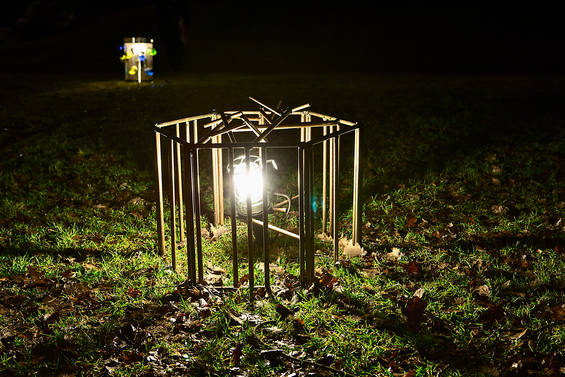 Various artists: Lantern Park. Photo: Marina Ekroos. © Visit Helsinki / Helsingin Markkinointi Oy.[/caption][caption id="attachment_1736" align="aligncenter" width="618"]
Various artists: Lantern Park. Photo: Marina Ekroos. © Visit Helsinki / Helsingin Markkinointi Oy.[/caption][caption id="attachment_1736" align="aligncenter" width="618"]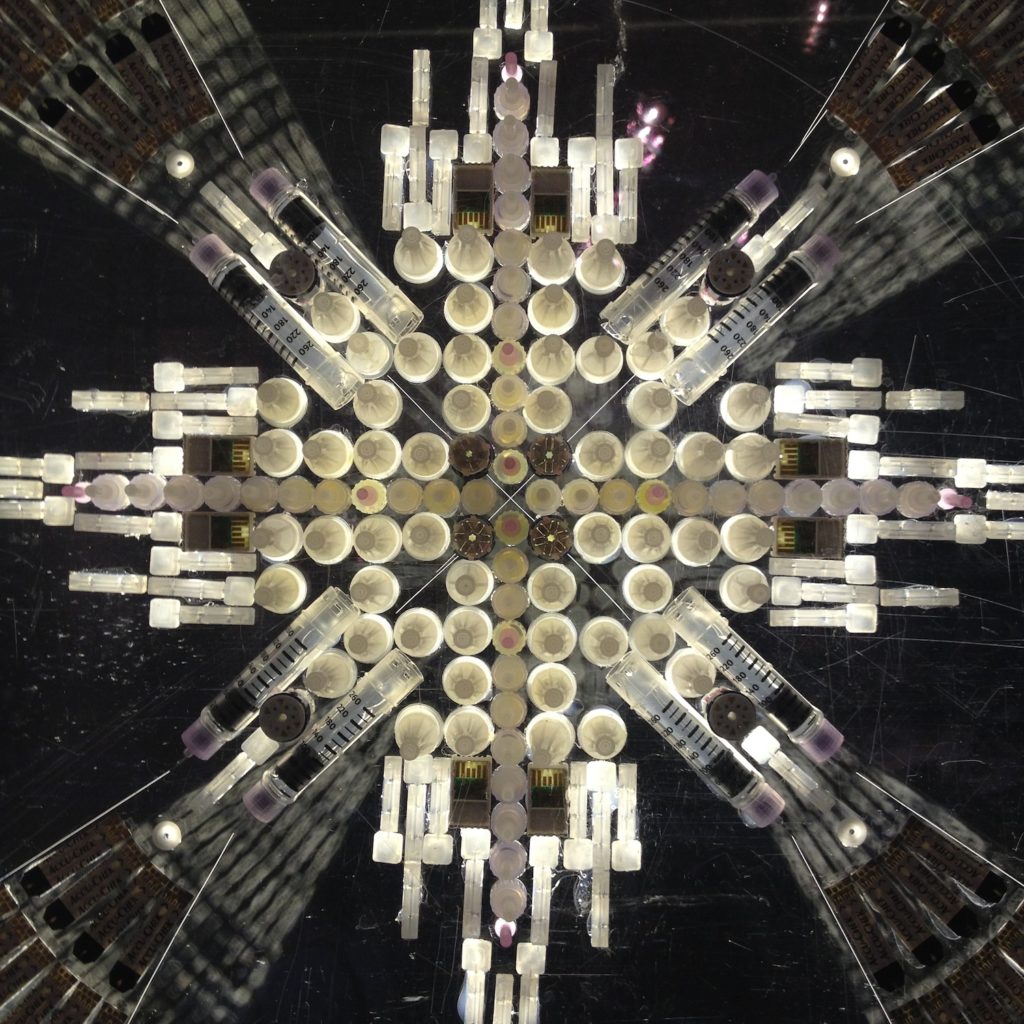 Ishmael Sandstroem: Mandala. Photo: Ilkka Paloniemi. © Visit Helsinki / Helsingin Markkinointi Oy.[/caption]One of the nice sides of LUX Helsinki is that the light festival takes you to places that you otherwise wouldn’t get to see, such as the internal courtyards of the National Museum. Looked at from a distance, the material of the Mandala artwork series in the museum’s Great Hall looks like bone or mother of pearl. The fragility of Ishmail Sandstroem’s artwork increases as you look at it close up: parts of the art work comprise of implements used for the treatment of diabetes which are lit by LEDs. Gleaming white in the museum’s Halkopiha courtyard is Universalis Helsinki. The basics don’t get much better than this. Abstract spatial sequences have been built inside a smart box that you can look at through window-like openings. You could imagine that the mentor here is James Turrell, the master of optical illusions.LUX Helsinki is a dynamic and surprising urban festival, which in a pleasing way is an unacademic potpourri of light, participants, architecture and places. For the friends of light the beginning of January is a good time to visit Helsinki. As a day-time bonus, you can observe one of the world’s most beautiful light phenomena, the low shining light of a cool winter’s day.Text by Anne Tervo.
English translation by Garreth Griffiths and Kristina Kölhi.
Photo source: LUX Helsinki 2015 © Visit Helsinki / Helsingin Markkinointi Oy.[caption id="attachment_1740" align="aligncenter" width="618"]
Ishmael Sandstroem: Mandala. Photo: Ilkka Paloniemi. © Visit Helsinki / Helsingin Markkinointi Oy.[/caption]One of the nice sides of LUX Helsinki is that the light festival takes you to places that you otherwise wouldn’t get to see, such as the internal courtyards of the National Museum. Looked at from a distance, the material of the Mandala artwork series in the museum’s Great Hall looks like bone or mother of pearl. The fragility of Ishmail Sandstroem’s artwork increases as you look at it close up: parts of the art work comprise of implements used for the treatment of diabetes which are lit by LEDs. Gleaming white in the museum’s Halkopiha courtyard is Universalis Helsinki. The basics don’t get much better than this. Abstract spatial sequences have been built inside a smart box that you can look at through window-like openings. You could imagine that the mentor here is James Turrell, the master of optical illusions.LUX Helsinki is a dynamic and surprising urban festival, which in a pleasing way is an unacademic potpourri of light, participants, architecture and places. For the friends of light the beginning of January is a good time to visit Helsinki. As a day-time bonus, you can observe one of the world’s most beautiful light phenomena, the low shining light of a cool winter’s day.Text by Anne Tervo.
English translation by Garreth Griffiths and Kristina Kölhi.
Photo source: LUX Helsinki 2015 © Visit Helsinki / Helsingin Markkinointi Oy.[caption id="attachment_1740" align="aligncenter" width="618"] Antonin Fourneau: Water Light Graffiti. © Visit Helsinki / Helsingin Markkinointi Oy.[/caption]
Antonin Fourneau: Water Light Graffiti. © Visit Helsinki / Helsingin Markkinointi Oy.[/caption]
Supernatural, amazing, fabulous
On Sunday evenings it’s normally quiet in the centre of Helsinki. Presently, however, there are people milling around as if it was a May Day parade. Friends of light dressed in their dark padded jackets wander along a route stretching from the Senate Square to Töölö bay. It’s almost pitch black and the first night of the five-day LUX Helsinki light event.On offer are 17 light installations by international teams of artists. The festival, arranged this year for the seventh time, attracts a monstrous 150 000 visitors. Families with children also participate; for them I would recommend taking a detour to visit the Unikuva [“Dreamscape”] workshops in the Annantalo cultural centre, where you can paint with light and create dream figures. All you insomniac kids get here immediately!Several of the works are interactive and visiting them all during a single night is an exhausting achievement. It’s worth deciding on a few picks or alternatively enjoying the festival atmosphere in the Helsinki night over the course of several evenings. Even though in places it is jam-packed with people, you cannot but feel joy as you follow the line meandering through the rear yard of the Villa Hakasalmi. Each person in turn gets to experience the amazing light and auditory world inside the wooden construction titled OVO. Sacral or astral – there is something supernatural here. Also thoughts about a cosmic egg, womb and new life emerge effortlessly.[caption id="attachment_1734" align="aligncenter" width="618"] ACT Lighting Design & Odeaubois: OVO. Photo: Janus van de Eijinden. © Visit Helsinki / Helsingin Markkinointi Oy.[/caption]
ACT Lighting Design & Odeaubois: OVO. Photo: Janus van de Eijinden. © Visit Helsinki / Helsingin Markkinointi Oy.[/caption]
 The Post Hall of the railway station is absolutely packed. Antonin Fourneau’s Water Light Graffiti is unambiguously interactive: it would not exist without participants. They paint patterns with water on a surface consisting of LEDs. On drying the water graffiti vanishes. The flow of people passing through the station hall emphasises in an excellent way the fleeting character of the art work. In a more dim light the graffiti would shine even brighter. Interactivity continues at the corner of the Finlandia Hall where the work Anonymous by the Lighting Design Collective Helsinki offers a protected cubicle containing a microphone and movement sensor. The marble facade of the building reproduces over a three-minute period the shape of the performer abstracted into unrecognisability. Very few inside the cubicle are able to stand still.The LUX Helsinki festival also includes artworks that are to be admired from a distance, and in that sense are more traditional. The installation at the Helsinki Cathedral was commissioned from Miika Riikonen to commemorate the 80th birthday of the composer Aulis Sallinen. The light licks the facades of the building accompanied by booming music, escaping behind the corner in order to return like a huge supermoon that has lost its orbit. The ability of the light beam to attract the gaze compensates for the detraction of the perception of the whole. In front of Helsinki University’s Porthania building people are standing quietly shoulder to shoulder. Mader Wiermann has conjured up a space-creating factory in the windows at street level, the shifting blocks of which shrink the scale of the building. Intentional or not, it’s possible to interpret the art work as a comment on the origins of Porthania, designed by architect Aarne Ervi and completed in 1957, when we recall that it’s one of the first significant buildings in Finland built from prefabricated concrete elements. Perhaps the boom and ruckus you hear comes instead from underground. Could it be that the book depositories in the basement have finally rebelled against the reading devices of the information era? Thomas A. Troge’s sound installation endorses this experience: yes, something may explode.The so-called Lantern Park, which in previous years has been located along Töölö bay, can this year be found in the Topelia block of Helsinki University. This is the most fabulous part of LUX Helsinki. The internal courtyard gathers together lanterns made by students from Aalto University and the University of the Arts Helsinki, bringing to mind people mingling at a party. That one over there has climbed up on to a balcony and is now peeking out through the railing. I wonder if the person is of an observant nature or just somewhat shy? Or perhaps the person really is an exhibitionist? And that young lady in the doorway lets the hem of her chiffon dress billow. At this time of night, tales of charming coquettes are more interesting than academic cubes and cylinders. Among the hundreds of lanterns there is fortunately something for everyone. With a grilled sausage in hand bought from the adjacent stall, you can set out to look for an art work that you feel portrays yourself.[caption id="attachment_1742" align="aligncenter" width="565"]
The Post Hall of the railway station is absolutely packed. Antonin Fourneau’s Water Light Graffiti is unambiguously interactive: it would not exist without participants. They paint patterns with water on a surface consisting of LEDs. On drying the water graffiti vanishes. The flow of people passing through the station hall emphasises in an excellent way the fleeting character of the art work. In a more dim light the graffiti would shine even brighter. Interactivity continues at the corner of the Finlandia Hall where the work Anonymous by the Lighting Design Collective Helsinki offers a protected cubicle containing a microphone and movement sensor. The marble facade of the building reproduces over a three-minute period the shape of the performer abstracted into unrecognisability. Very few inside the cubicle are able to stand still.The LUX Helsinki festival also includes artworks that are to be admired from a distance, and in that sense are more traditional. The installation at the Helsinki Cathedral was commissioned from Miika Riikonen to commemorate the 80th birthday of the composer Aulis Sallinen. The light licks the facades of the building accompanied by booming music, escaping behind the corner in order to return like a huge supermoon that has lost its orbit. The ability of the light beam to attract the gaze compensates for the detraction of the perception of the whole. In front of Helsinki University’s Porthania building people are standing quietly shoulder to shoulder. Mader Wiermann has conjured up a space-creating factory in the windows at street level, the shifting blocks of which shrink the scale of the building. Intentional or not, it’s possible to interpret the art work as a comment on the origins of Porthania, designed by architect Aarne Ervi and completed in 1957, when we recall that it’s one of the first significant buildings in Finland built from prefabricated concrete elements. Perhaps the boom and ruckus you hear comes instead from underground. Could it be that the book depositories in the basement have finally rebelled against the reading devices of the information era? Thomas A. Troge’s sound installation endorses this experience: yes, something may explode.The so-called Lantern Park, which in previous years has been located along Töölö bay, can this year be found in the Topelia block of Helsinki University. This is the most fabulous part of LUX Helsinki. The internal courtyard gathers together lanterns made by students from Aalto University and the University of the Arts Helsinki, bringing to mind people mingling at a party. That one over there has climbed up on to a balcony and is now peeking out through the railing. I wonder if the person is of an observant nature or just somewhat shy? Or perhaps the person really is an exhibitionist? And that young lady in the doorway lets the hem of her chiffon dress billow. At this time of night, tales of charming coquettes are more interesting than academic cubes and cylinders. Among the hundreds of lanterns there is fortunately something for everyone. With a grilled sausage in hand bought from the adjacent stall, you can set out to look for an art work that you feel portrays yourself.[caption id="attachment_1742" align="aligncenter" width="565"] Various artists: Lantern Park. Photo: Marina Ekroos. © Visit Helsinki / Helsingin Markkinointi Oy.[/caption][caption id="attachment_1736" align="aligncenter" width="618"]
Various artists: Lantern Park. Photo: Marina Ekroos. © Visit Helsinki / Helsingin Markkinointi Oy.[/caption][caption id="attachment_1736" align="aligncenter" width="618"] Ishmael Sandstroem: Mandala. Photo: Ilkka Paloniemi. © Visit Helsinki / Helsingin Markkinointi Oy.[/caption]One of the nice sides of LUX Helsinki is that the light festival takes you to places that you otherwise wouldn’t get to see, such as the internal courtyards of the National Museum. Looked at from a distance, the material of the Mandala artwork series in the museum’s Great Hall looks like bone or mother of pearl. The fragility of Ishmail Sandstroem’s artwork increases as you look at it close up: parts of the art work comprise of implements used for the treatment of diabetes which are lit by LEDs. Gleaming white in the museum’s Halkopiha courtyard is Universalis Helsinki. The basics don’t get much better than this. Abstract spatial sequences have been built inside a smart box that you can look at through window-like openings. You could imagine that the mentor here is James Turrell, the master of optical illusions.LUX Helsinki is a dynamic and surprising urban festival, which in a pleasing way is an unacademic potpourri of light, participants, architecture and places. For the friends of light the beginning of January is a good time to visit Helsinki. As a day-time bonus, you can observe one of the world’s most beautiful light phenomena, the low shining light of a cool winter’s day.Text by Anne Tervo.
English translation by Garreth Griffiths and Kristina Kölhi.
Photo source: LUX Helsinki 2015 © Visit Helsinki / Helsingin Markkinointi Oy.[caption id="attachment_1740" align="aligncenter" width="618"]
Ishmael Sandstroem: Mandala. Photo: Ilkka Paloniemi. © Visit Helsinki / Helsingin Markkinointi Oy.[/caption]One of the nice sides of LUX Helsinki is that the light festival takes you to places that you otherwise wouldn’t get to see, such as the internal courtyards of the National Museum. Looked at from a distance, the material of the Mandala artwork series in the museum’s Great Hall looks like bone or mother of pearl. The fragility of Ishmail Sandstroem’s artwork increases as you look at it close up: parts of the art work comprise of implements used for the treatment of diabetes which are lit by LEDs. Gleaming white in the museum’s Halkopiha courtyard is Universalis Helsinki. The basics don’t get much better than this. Abstract spatial sequences have been built inside a smart box that you can look at through window-like openings. You could imagine that the mentor here is James Turrell, the master of optical illusions.LUX Helsinki is a dynamic and surprising urban festival, which in a pleasing way is an unacademic potpourri of light, participants, architecture and places. For the friends of light the beginning of January is a good time to visit Helsinki. As a day-time bonus, you can observe one of the world’s most beautiful light phenomena, the low shining light of a cool winter’s day.Text by Anne Tervo.
English translation by Garreth Griffiths and Kristina Kölhi.
Photo source: LUX Helsinki 2015 © Visit Helsinki / Helsingin Markkinointi Oy.[caption id="attachment_1740" align="aligncenter" width="618"] Antonin Fourneau: Water Light Graffiti. © Visit Helsinki / Helsingin Markkinointi Oy.[/caption]
Antonin Fourneau: Water Light Graffiti. © Visit Helsinki / Helsingin Markkinointi Oy.[/caption]